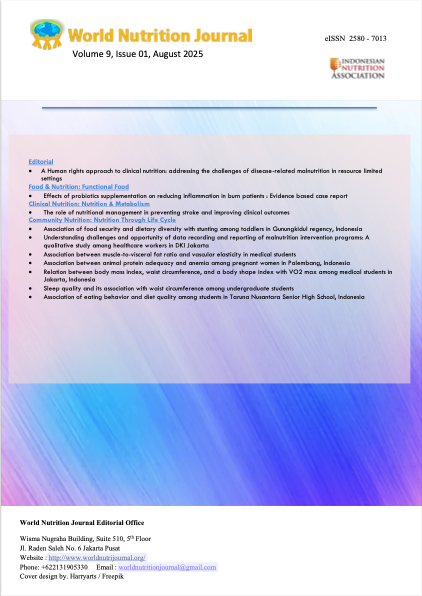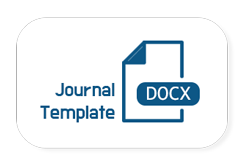Understanding challenges and opportunity of data recording and reporting of malnutrition intervention programs
A qualitative study among healthcare workers in DKI Jakarta
Abstract
Background: The number of stunting in Indonesia was reported to be 21.6% in 2022, still far from the 2024 target of 14%. The large-scale programs of nutrition-specific intervention have been done, including moderate-acute malnutrition (MAM) and severe-acute malnutrition (SAM) interventions. However, limited findings on the process of monitoring and evaluation of both interventions. Objective: This paper aims to describe the implementation, challenges, and opportunities of malnutrition intervention data recording and reporting among healthcare workers in DKI Jakarta Province, Indonesia. Methods: Qualitative data collection was taken with in-depth interview (IDI) and focus group discussion (FGD) in August-October 2024 towards healthcare workers in selected Puskesmas in DKI Jakarta who were involved with MAM and SAM interventionss and data management. Data triangulation was done to health cadres and mothers of children under five (CU-5) as the beneficiaries. Results: This study involved eight informants from South and Central Jakarta Puskesmas, and 16 cadres and 13 mothers who were involved in MAM and SAM interventionss. The dissemination and adaptation of indicators has been done and digital data recording has been used, despite its lack of supporting resources and data integration which may affect its data quality. Leveraging resources and enabling data-sharing between facilities and maintaining communication between stakeholders are essential. Conclusions: The process of data recording and reporting of malnutrition interventions required well-informed indicators, trained personnel, and streamlined information systems. Maintaininghigh quality data, collaboration between stakeholders and utilizing accessible technology are recommended for the healthcare worker to improve the process of data recording and reporting.Downloads
References
Worldometer. Asian Countries by Population. Worldometers. 2023. https://www.worldometers.info/population/countries-in-asia-by-population/
UNICEF/WHO/The World Bank. Joint Child Malnutrition Estimates. Levels and trends in child malnutrition: key findings of the 2022 edition. World Health Organization, Geneva. 2019
Indonesia Ministry of Health. Survei Status Gizi Indonesia. Indonesia. Ministry of Health. 2022. https://ayosehat.kemkes.go.id/pub/files/files46531._MATERI_KABKPK_SOS_SSGI.pdf
Presiden Republik Indonesia. Peraturan Presiden Republik Indonesia Nomor 72 Tahun 2021 Tentang Percepatan Penurunan Stunting. Jakarta. Kementerian Sekretariat Negara Republik Indonesia. 2021.
Ministry of Health of the Republic of Indonesia. Publication of Specific and Sensitive Intervention Data for the Acceleration of Stunting Reduction Q3 2023 [video]. Jakarta: Ministry of Health RI; 2023. Available from: https://www.youtube.com/watch?v=2kBKEAq5qWU
Scaling Up Nutrition. Case Study: Implementation of Nutrition-Sensitive Interventions to Improve Food and Nutrition Security in Kenya and Honduras. Scaling Up Nutrition. 2022.
Vahabi A, Nasirzadeh F, Mills A. Assessing the impact of project brief clarity using project definition rating index tool and system dynamic. Eng Constr Archit Manag. 2022;Ahead-of-print. doi:10.1108/ECAM-07-2021-0618
Brian M. Belcher, Rachel Claus, Rachel Davel, Frank Place, Indicators for monitoring and evaluating research-for-development: A critical review of a system in use, Environmental and Sustainability Indicators,Volume 24, 2024, 100526, ISSN 2665-9727, https://doi.org/10.1016/j.indic.2024.100526.
Novianda, A., Esti, K. Transformasi Digital Layanan Kesehatan Terhambat Tata Kelola Data. CIPG. 2022.
Whyte, Stella & Omoyiola, Bayo Olushola. Integration of Public and Private Health Care Data with Machine Learning. 2023. DOI: 10.5281/zenodo.7650261.
Sinha, Rajesh & Sinha, Archana. Knowledge, Attitude and Practice of Health Information System. Journal of Health Management. (2015). 17. 425-437. 10.1177/0972063415606268.
Whittaker, M., Mares, RE., Rodney, A. Mapping health information system competencies for health workers in low- and middle-income countries. Working Paper Series, Number 30 , August 2013. School of Population Health, University of Queensland.
Dash, S., Shakyawar, S.K., Sharma, M. et al. Big data in healthcare: management, analysis and future prospects. J Big Data 6, 54 (2019). https://doi.org/10.1186/s40537-019-0217-0
Das, Jai K et al. “Effectiveness of Interventions for Managing Acute Malnutrition in Children under Five Years of Age in Low-Income and Middle-Income Countries: A Systematic Review and Meta-Analysis.” Nutrients vol. 12,1 116. 1 Jan. 2020, doi:10.3390/nu12010116
Das, Jai K et al. “Effectiveness of Interventions for Managing Acute Malnutrition in Children under Five Years of Age in Low-Income and Middle-Income Countries: A Systematic Review and Meta-Analysis.” Nutrients vol. 12,1 116. 1 Jan. 2020, doi:10.3390/nu12010116
Manivannan MM, Vaz M, Swaminathan S. Perceptions of healthcare providers and mothers on management and care of severely wasted children: a qualitative study in Karnataka, India. BMJ Open 2023;13:e067592. doi:10.1136/ bmjopen-2022-067592
Lenters, Lindsey M et al. “Treatment of severe and moderate acute malnutrition in low- and middle-income settings: a systematic review, meta-analysis and Delphi process.” BMC public health vol. 13 Suppl 3,Suppl 3 (2013): S23. doi:10.1186/1471-2458-13-S3-S23
Badan Pusat Statistik Jakarta. Jumlah Penduduk Provinsi DKI Jakarta Menurut Kelompok Umur dan Jenis Kelamin [Internet]. Jakarta: Badan Pusat Statistik Jakarta; [cited 2025 Jan 24]. Available from: https://jakarta.bps.go.id/id/statistics-table/2/MTExIzI=/jumlah-penduduk-provinsi-dki-jakarta-menurut-kelompok-umur-dan-jenis-kelamin.html
WHO-UNICEF. Use of Nutrition Data in Decision Making:A Review Paper. 2020. https://cdn.who.int/media/docs/default-source/nutritionlibrary/team---technical-expert-advisory-group-on-nutrition-monitoring/team-nutrition-data-decisionmaking-reviewpaper.pdf?sfvrsn=43b43e17_2&download=true
UN Global Pulse. Assessing the Implementation of Indonesia's National Nutrition Information System: e-PPGBM Challenges, Gaps, and Opportunities. 2023.
Kemenkes RI. Petunjuk Teknis Pemberian Makanan Tambahan (ADDITIONAL FOOD) Berbahan Pangan Lokal untuk Balita dan Ibu Hamil. 2023. https://kesmas.kemkes.go.id/assets/uploads/contents/others/20230516_Juknis_Tatalaksana_Gizi_V18.pdf
Kepmenkes 1186/2022 tentang PPK bagi Dokter di FKTP dan SPO Pencegahan dan Tatalaksana Gizi Buruk
Aisyah DN, Setiawan AH, Lokopessy AF, Faradiba N, Setiaji S, Manikam L, Kozlakidis Z. The Information and Communication Technology Maturity Assessment at Primary Health Care Services Across 9 Provinces in Indonesia: Evaluation Study. JMIR Med Inform 2024;12:e55959 doi: 10.2196/55959 PMID: 39037345 PMCID: 11269960
Siyam, A., Ir, P., York, D. et al. The burden of recording and reporting health data in primary health care facilities in five low- and lower-middle income countries. BMC Health Serv Res 21 (Suppl 1), 691 (2021). https://doi.org/10.1186/s12913-021-06652-5
Bosch-Capblanch X, Ronveaux O, Doyle V, Remedios V, Bchir A. Health systems performance in low-income countries: benchmarking tools and potential to empower decision-making and enhance accountability. Health Policy Plan. 2009;24(2):76–83.
Gupta N, Maliqi B, França A, et al. Human resources for maternal, newborn and child health: from measurement and planning to performance for improved health outcomes. Hum Resour Health. 2011;9:16.
Fraser H, McGrath S. Information technology and telemedicine in sub-Saharan Africa. BMJ. 2000;321(7259):465-6.
National Institutes of Health. Electronic health records overview. Bethesda: NIH; 2019.
Sari M, Bloem MW, Sunarsih E, et al. Impact of Daily versus Weekly Supply of Locally Produced Ready-to-Use Food (RUF) for Mildly Wasted Children on Nias Island, Indonesia. Nutrients. 2014;6(1):1-12.
Tang, Daisheng et al. “Mobility-related inequality in healthcare utilization between floating and native populations and its influencing factors: evidence from China.” International health vol. 14,5 (2022): 475-484. doi:10.1093/inthealth/ihab036
Pithara, Christalla & Zembylas, Michalinos & Theodorou, Mamas. (2012). Access and effective use of healthcare services by temporary migrants in Cyprus. International Journal of Migration, Health and Social Care. 10.1108/17479891211250012.
Kementerian Kesehatan Republik Indonesia. SATUSEHAT Platform [Internet]. Jakarta: Kementerian Kesehatan RI; [cited 2024 Dec 8]. Available from: https://satusehat.kemkes.go.id/platform
Swendeman D, Comulada WS, Ramanathan N, Lazar M, Estrin D. Reliability and validity of daily self-monitoring by smartphone application for health-related quality-of-life, antiretroviral adherence, substance use, and sexual behaviors among people living with HIV. AIDS Behav. 2015 Feb;19(2):330-40. doi: 10.1007/s10461-014-0923-8. PMID: 25331266; PMCID: PMC4344409.
Donaldson, Stewart & Grant-Vallone, Elisa. (2002). Understanding Self-Report Bias in Organizational Behavior Research. Journal of Business and Psychology. 17. 245-260. 10.1023/A:1019637632584.
Biga, R., Nottebaum, S., Kozlakidis, Z., Psomiadis, S. (2024). Digitalization of Healthcare in LMICs: Digital Health and the Digital Divide Based on Technological Availability and Development. In: Kozlakidis, Z., Muradyan, A., Sargsyan, K. (eds) Digitalization of Medicine in Low- and Middle-Income Countries. Sustainable Development Goals Series. Springer, Cham. https://doi.org/10.1007/978-3-031-62332-5_18
Castaño, Paula M et al. “Using digital technologies to improve treatment adherence.” Clinical obstetrics and gynecology vol. 56,3 (2013): 434-45. doi:10.1097/GRF.0b013e3182988a3b
Ismail, Rita et al. “Feasibility of Lantern Using WhatsApp to Improve Antiretroviral Therapy Adherence.” Computers, informatics, nursing : CIN vol. 41,11 915-920. 1 Nov. 2023, doi:10.1097/CIN.0000000000001054
Ershad Sarabi, Roghayeh et al. “The Effectiveness of Mobile Phone Text Messaging in Improving Medication Adherence for Patients with Chronic Diseases: A Systematic Review.” Iranian Red Crescent medical journal vol. 18,5 e25183. 30 Apr. 2016, doi:10.5812/ircmj.25183
Submitted
Copyright (c) 2025 Chyntia Aryanti Mayadewi, Dian Novita Chandra, Judhiastuty Februhartanty

This work is licensed under a Creative Commons Attribution 4.0 International License.
World Nutrition Journal provides immediate open access to its content under the Creative Commons Attribution License (CC BY 4.0). This permits unrestricted use, distribution, and reproduction in any medium, provided the original work is properly cited.













